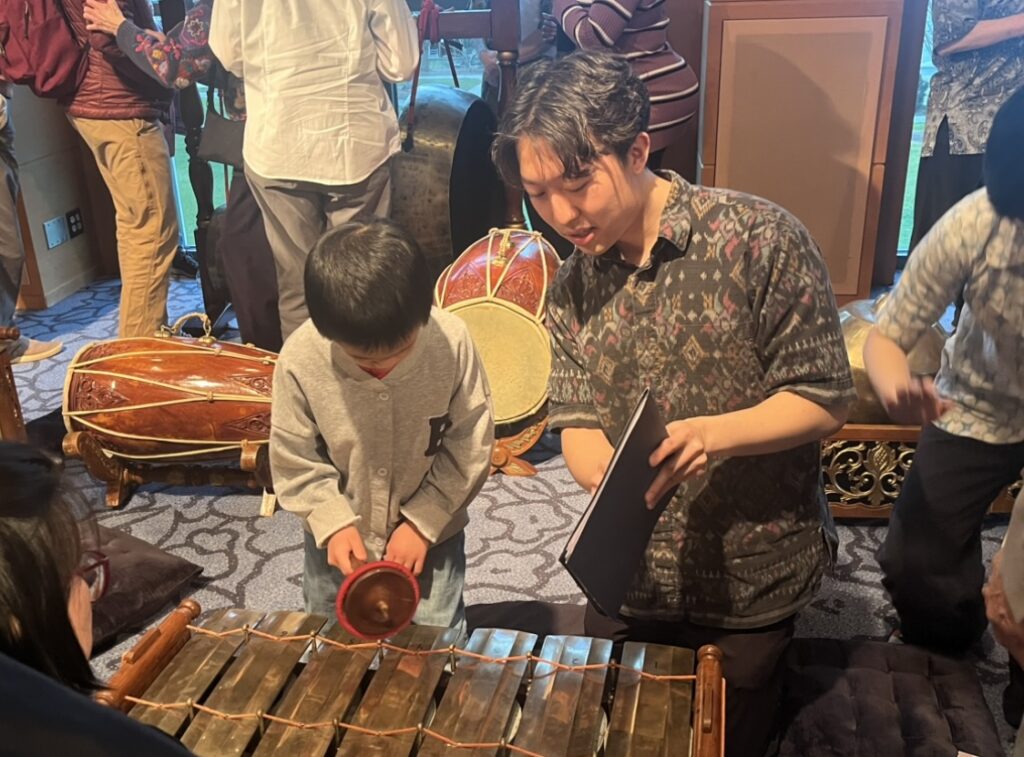 (Amiee Zhao/Arts & Life Editor)
(Amiee Zhao/Arts & Life Editor)
The gentle sound of percussion instruments and the high pitch of flutes surrounded the Michael C. Carlos Museum on Jan. 28. In Ackerman Hall, Emory Gamelan Ensemble practiced one last time for their first concert of the semester. When the door opened, audience members walked into the warmly lit hall, where a set of gamelan instruments rested in the front. The instrumentalists and singers seated themselves on the carpet, barefoot. The host, Ingram Director of Education at the Carlos Museum Katie Ericson, encouraged audience members to join the musicians and sit on the floor.
Emory Gamelan Ensemble, directed by Darsono Hadiraharjo, perform a series of traditional Indonesian arts, including karawitan musical concerts, wayang shadow puppet shows and ritual dances. The ensemble consists of students, faculty and community members. Their first concert this semester was a free, educational session where the ensemble played karawitan music from Central Java, Indonesia. A group of nine instrumentalists and singers performed three pieces in the karawitan music repertoire in a chamber music style called gadhon.
The first piece, “Puspanjala,” is a classic karawitansong that describes different varieties of flowers to praise the characteristics of an ideal woman, according to the concert program. With the singers’ voices threaded through the instrumentals, switching between high and low tunes constantly and unexpectedly, the piece moved forward at a light, comforting pace. Five minutes into the performance, some audience members closed their eyes, their bodies swaying gently to the merry beats of the piece. Many of them, instead of simply listening to the music, tilted their bodies forward and scrutinized the traditional gamelan musical instruments with their eyes.
Before moving onto the second piece, Assistant Professor of Ethnomusicology Maho Ishiguro, who is Hadiraharjo’s wife, introduced the audience to the various instruments on stage. Kempul, which is an enormous percussion instrument, provides the undertone of karawitanmusic by setting a calming bass sound for the ensemble. The audience gasped at the lasting resonance of kempul when the player striked it during Ishiguro’s introduction. Other instruments included suling (bamboo flute), kenong (set of percussion instruments), rebab (string instrument),kendhang (drums), gambang (wooden xylophone) and gender (bronze metallophone). Two singers complemented the musical instruments with their chants in Javanese.
Ishiguro also answered an audience member’s question about gamelan music notations. She described how gamelan music, despite its recent development of some notations, relies more on oral learning, which means remembering music without the notations found in Western music.
The musicians on stage broke down the musical elements of the second piece, “Wilujeng,” which is a prayer for one’s well-being. They demonstrated the different layers of karawitan music by starting the first section of the piece with only percussion instruments. The melodies of suling, gender and musicians’ voices followed. Finally, rebab joined the layers of sounds, providing the main melody.
The final piece, “Asmaradana,” is a romantic accompaniment to a variety of court dances in Javanese culture. “Asmara” means love, while “dana” evolved from the word “dahana,” which means burning fire. The piece became more rhythmic as it proceeded, with interlocking melodies and smooth chants. The pace of the music also gradually increased, bringing a merry end to the concert.
At the end of the performance, Emory Gamelan Ensemble invited the audience to try out various instruments themselves while having conversations with the musicians.
“This is the first time I actually have been in a community that has had a gamelan [ensemble],” local resident Paul Edsom said, recalling his experience listening to recordings of gamelan music before.
Practicing gamelan music is a rigorous process that is not always easily accessible.
“With gamelan music, four parts are written down, but other parts aren’t written down,” Ishiguro said when recounting her experience of Hadiraharjo teaching her how to play gamelan instruments. “For that, you need to know the theory to know how to drive your improvisational parts. And then after that, it is a little bit of oral learning, knowing and memorizing how patterns and formulas work within that structural, theoretical framework.”
Ishiguro pointed out that to be a professional gamelan music player, one needs to be able to understand and perform every kind of gamelan instrument for better coordination.
Although learning gamelan music can be difficult without standardized scores, its the personal, collaborative nature appeals to Ishiguro.
“[Playing] piano gets a little lonely,” she said when explaining why she started learning gamelan music as a pianist. “I want to switch it to something a little bit more communal or friendly.”
Hadiraharjo also emphasized his collaborative approaches to directing the ensemble, stating that he tries to make the ensemble like a family.
The unique charisma of gamelan music also appeals Runyu Huang (25C).
“I like how it’s calming,” Huang said. “It’s just a lot less stressful.”
Edsom also commented on the benefit of having diverse groups, such as the ensemble, sharing their culture and practices.
“It’s a very good idea to have as much multicultural experience as possible,” Edsom said. “We can’t always go to very, very different parts of the world.”
Through this educational concert, Emory Gamelan Ensemble helped enliven traditional gamelan music and culture by encouraging people to gather and appreciate the music as a community. Yet, Ishiguro highlighted that such cultural events are scarce.
“At Emory, we have a very special place,” Ishiguro said. “There just aren’t that many music groups that are outside of the West.”
Emory Gamelan Ensemble’s next performance will take place in Performing Arts Studio on April 13. In addition to playing music, the ensemble will be presenting Javanese shadow puppetry theater.
Update (2/3/2024 at 11p.m.): Emory Gamelan Ensemble's next performance will also feature Javanese music instead of only presenting Javanese shadow puppetry theater.





